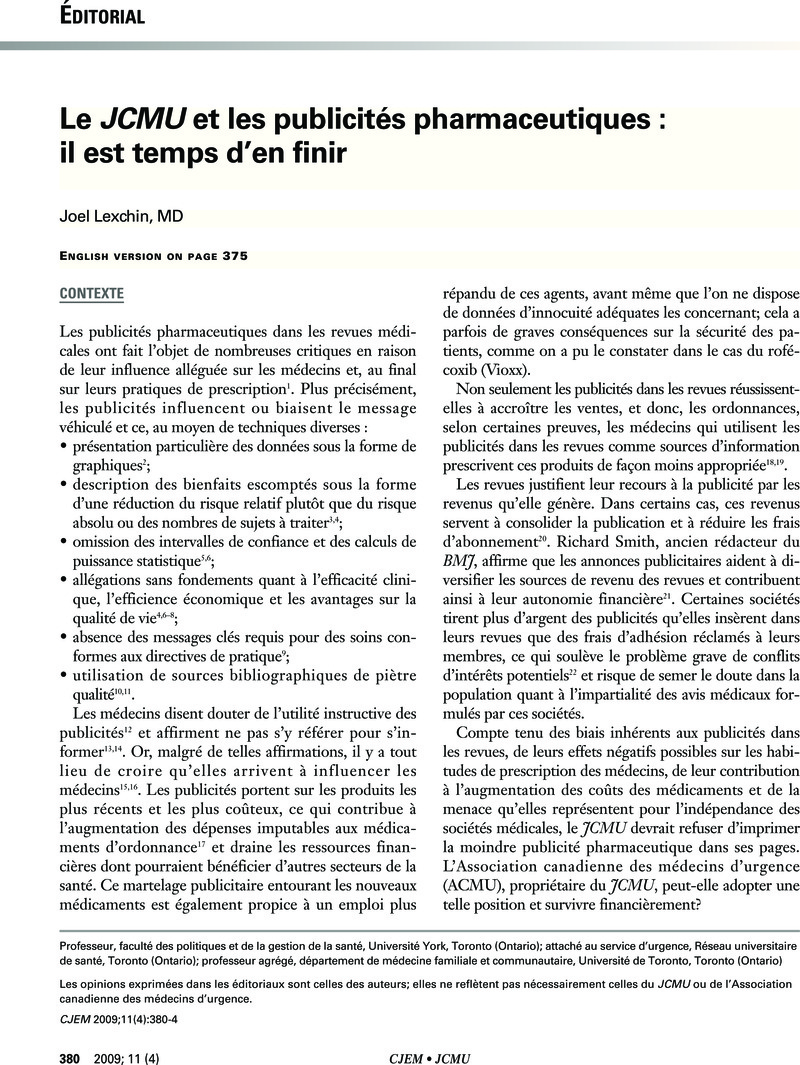No CrossRef data available.
Article contents
Le JCMU et les publicités pharmaceutiques : il est temps d’en finir
Published online by Cambridge University Press: 21 May 2015
Abstract
An abstract is not available for this content so a preview has been provided. As you have access to this content, a full PDF is available via the ‘Save PDF’ action button.

- Type
- Éditorial
- Information
- Copyright
- Copyright © Canadian Association of Emergency Physicians 2009
References
RÉFÉRENCES
1.
Wilkes, MS, Doblin, BH, Shapiro, MF. Pharmaceutical advertisements in leading medical journals: experts’ assessments. Ann Intern Med
1992;116:912–9.CrossRefGoogle ScholarPubMed
2.
Cooper, RJ, Schriger, DL, Wallace, RC, et al. Graphics in pharmaceutical advertisements: Are they truthful, are they adequately detailed? Plenary session at the Fourth International Congress on Peer Review in Biomedical Publication; 2001 Sep. 14–16; Barcelona (Spain): JAMA and BMJ Publishing Group; 2001. Available: http://www.ama-assn.org/public/peer/prc_program2001.htm#truthful (accessed 2009 May 15).Google Scholar
3.
Lexchin, J. How patient outcomes are reported in drug advertisements: review of Canadian medical journals. Can Fam Physician
1999;45:1213–6.Google Scholar
4.
Loke, TW, Koh, FC, Ward, JE. Pharmaceutical advertisement claims in Australian medical publications: Is evidence accessible, compelling and communicated comprehensively?
Med J Aust
2002;177:291–3.CrossRefGoogle Scholar
5.
Gutknecht, DR. Evidence-based advertising? A survey of four major journals. J Am Board Fam Pract
2001;14:197–200.Google ScholarPubMed
6.
Lankinen, KS, Levola, T, Marttinen, K, et al. Industry guidelines, laws and regulations ignored: quality of drug advertising in medical journals. Pharmacoepidemiol Drug Saf
2004;13: 789–95.CrossRefGoogle ScholarPubMed
7.
Neumann, PJ, Bambauer, KZ, Ramakrishnan, V, et al. Economic messages in prescription drug advertisements in medical journals. Med Care
2002;40:840–5.CrossRefGoogle ScholarPubMed
8.
Spielmans, GI, Thielges, SA, Dent, AL, et al. The accuracy of psychiatric medication advertisements in medical journals. J Nerv Ment Dis
2008;196:267–73.CrossRefGoogle ScholarPubMed
9.
Montgomery, BD, Mansfield, PR, Spurling, GK, et al. Do advertisements for antihypertensive drugs in Australia promote quality prescribing? A cross-sectional study. BMC Public Health
2008;8:167.CrossRefGoogle ScholarPubMed
10.
Cooper, RJ, Schriger, DL. The availability of references and the sponsorship of original research cited in pharmaceutical advertisements. CMAJ
2005;172:487–91.CrossRefGoogle ScholarPubMed
11.
Lexchin, J, Holbrook, A. Methodologic quality and relevance of references in pharmaceutical advertisements in a Canadian medical journal. CMAJ
1994;151:47–54.Google Scholar
12.
Hemeryck, L, Chan, R, McCormack, PME, et al. Pharmaceutical advertisements in Irish medical journals. J Pharm Med. 1995;5:147–51.Google Scholar
13.
McGettigan, P, Golden, J, Fryer, J, et al. Prescribers prefer people: the sources of information used by doctors for prescribing suggest that the medium is more important than the message. Br J Clin Pharmacol
2001;51:184–9.CrossRefGoogle Scholar
14.
Prosser, H, Almond, S, Walley, T. Influences on GPs’ decision to prescribe new drugs — the importance of who says what. Fam Pract
2003;20:61–8.CrossRefGoogle Scholar
15.
Avorn, J, Chen, M, Hartley, R. Scientific versus commercial sources of influence on the prescribing behavior of physicians. Am J Med
1982;73:4–8.CrossRefGoogle ScholarPubMed
16.
Greenwood, J. Pharmaceutical representatives and the prescribing of drugs by family doctors [dissertation]. Nottingham (UK): Nottingham University; 1989.Google Scholar
17.
Findlay, S. Prescription drugs and mass media advertising. Washington (DC): National Institute for Health Care Management Research and Educational Foundation; 2000.Google Scholar
18.
Bower, AD, Burkett, GL. Family physicians and generic drugs: a study of recognition, information sources, prescribing attitudes and practices. J Fam Pract
1987;24:612–6.Google ScholarPubMed
19.
Ferry, ME, Lamy, PP, Becker, LA. Physicians’ knowledge of prescribing for the elderly: a study of primary care physicians in Pennsylvania. J Am Geriatr Soc
1985;33:616–21.CrossRefGoogle ScholarPubMed
20.
Fletcher, RH. Adverts in medical journals: caveat lector. Lancet
2003;361:10–1.CrossRefGoogle ScholarPubMed
21.
Smith, R. Should medical journals carry drug advertising?
BMJ
2007;335:74.CrossRefGoogle ScholarPubMed
22.
Glassman, PA, Hunter-Hayes, J, Nakamura, T. Pharmaceutical advertising revenue and physician organizations: How much is too much?
West J Med
1999;171:234–8.Google ScholarPubMed
23.
Fugh-Berman, A, Alladin, K, Chow, J. Advertising in medical journals: Should current practices change?
PLoS Med
2006;3:e130.Google ScholarPubMed
24.
Conseil consultatif de publicité pharmaceutique. Code d'agrément de la publicité. Pickering (ON): le Conseil; 2007.Google Scholar
25.
Lexchin, J, Light, D. Commercial influence and the content of medical journals. BMJ
2006;332:1444–7.CrossRefGoogle ScholarPubMed
26.
Mansfield, PR, Lexchin, J, Wen, LS, et al. Educating health professionals about drug and device promotion: advocates’ recommendations. PLoS Med
2006;3:e451.CrossRefGoogle ScholarPubMed


